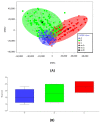S100B Affects Gut Microbiota Biodiversity
- PMID: 36768570
- PMCID: PMC9916897
- DOI: 10.3390/ijms24032248
S100B Affects Gut Microbiota Biodiversity
Abstract
This in vivo study in mice addresses the relationship between the biodiversity of the microbiota and the levels of S100B, a protein present in enteroglial cells, but also in foods such as milk. A positive significant correlation was observed between S100B levels and Shannon values, which was reduced after treatment with Pentamidine, an inhibitor of S100B function, indicating that the correlation was influenced by the modulation of S100B activity. Using the bootstrap average method based on the distribution of the S100B concentration, three groups were identified, exhibiting a significant difference between the microbial profiles. Operational taxonomic units, when analyzed by SIMPER analysis, showed that genera regarded to be eubiotic were mainly concentrated in the intermediate group, while genera potentially harboring pathobionts often appeared to be more concentrated in groups where the S100B amounts were very low or high. Finally, in a pilot experiment, S100B was administered orally, and the microbial profiles appeared to be modified accordingly. These data may open novel perspectives involving the possibility of S100B-mediated regulation in the intestinal microbiota.
Keywords: 16S amplicon sequencing; IBD; NGS; Pentamidine; S100B; eubiosis; gut–brain axis; mfDNA; microbiome; milk; protein-binding domain.
Conflict of interest statement
The authors declare no conflict of interest.
Figures




References
-
- Michetti F., Di Sante G., Clementi M.E., Sampaolese B., Casalbore P., Volonté C., Romano Spica V., Parnigotto P.P., Di Liddo R., Amadio S., et al. Growing role of S100B protein as a putative therapeutic target for neurological- and nonneurological-disorders. Neurosci. Biobehav. Rev. 2021;127:446–458. doi: 10.1016/j.neubiorev.2021.04.035. - DOI - PubMed
MeSH terms
Substances
LinkOut - more resources
Full Text Sources
Miscellaneous

